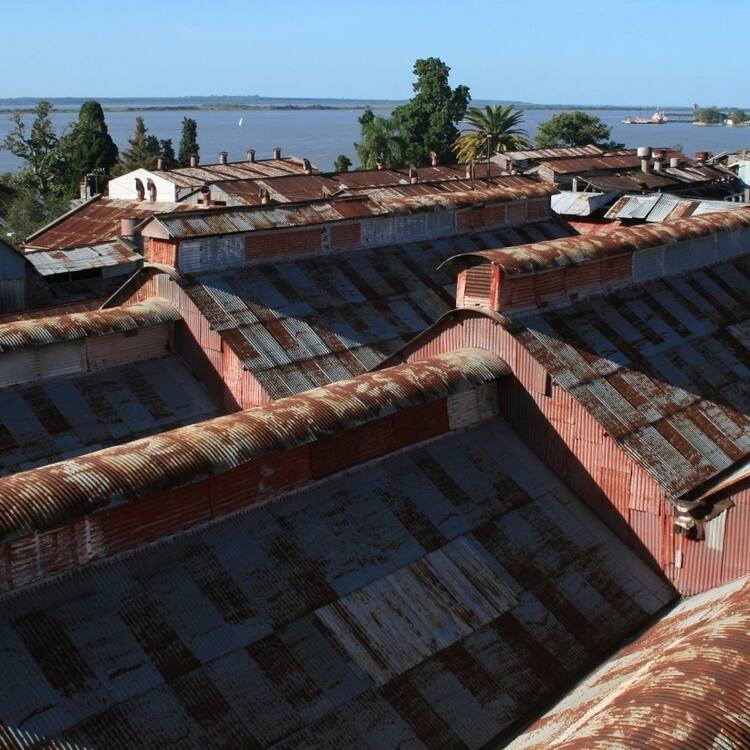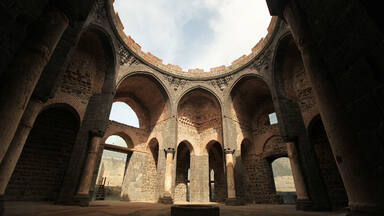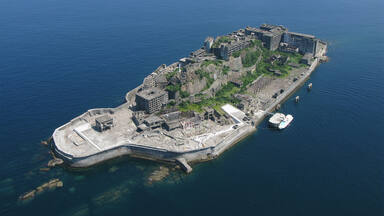Fray Bentos Industrial Landscape
Fray Bentos Industrial Landscape
Located on land projecting into the Uruguay River west of the town of Fray Bentos, the industrial complex was built following the development of a factory founded in 1859 to process meat produced on the vast prairies nearby. The site illustrates the whole process of meat sourcing, processing, packing and dispatching. It includes buildings and equipment of the Liebig Extract of Meat Company, which exported meat extract and corned-beef to the European market from 1865 and the Anglo Meat Packing Plant, which exported frozen meat from 1924. Through its physical location, industrial and residential buildings as well as social institutions, the site presents an illustration of the entire process of meat production on a global scale.
Description is available under license CC-BY-SA IGO 3.0
Paysage industriel de Fray Bentos
Construit sur une avancée de terre sur le fleuve Uruguay, à l’ouest de la ville de Fray Bentos, le complexe industriel est né du développement d’une usine de salaison de viandes fondée en 1859 dans le but de tirer partie de l’élevage de bétail qu’abritaient les immenses prairies voisines. Illustrant toute la chaîne de la viande – approvisionnement, transformation, emballage et expédition - le site comprend des bâtiments et des équipements de la Liebig Extract of Meat Company, qui exporta du concentré de viande et du corned-beef sur le marché européen à partir de 1865 et de l’Anglo Meat Packing Plant, qui exporta de la viande surgelée à partir de 1924. La combinaison du lieu, de l’ensemble industriel, des logements et des institutions sociales présents sur le site permet de comprendre tout le processus d’une production de viande d’envergure mondiale.
Description is available under license CC-BY-SA IGO 3.0
موقع فراي بنتوس الثقافي الصناعي
بُني المجمع الصناعي على ضفاف نهر أوروغواي، غرب مدينة فراي بنتوس، وقد بصر النور نتيجةً لتوسيع مصنع لتمليح اللحوم أنشئ في عام 1859 بغية الاستفادة من الماشية التي كانت تربى في المراعي الشاسعة المجاورة للمصنع. ويبرِز الموقع عملية معالجة اللحوم بمراحلها كافة، بدءاً بالتموين والتحويل وانتهاءً بالتعليب والتصدير، ويشمل عدداً من المباني والمعدات التابعة لشركة "ليبيغ إكستراكت أوف مِيت" (Liebig Extract of Meat Company) التي بدأت بتصدير مركّز للحوم ولحم بقر معلّب إلى السوق الأوروبية اعتباراً من عام 1865، وشركة "أنغلو مِيت باكنغ بلانت" (Anglo Meat Packing Plant) التي شرعت في تصدير اللحوم المجمدة اعتباراً من عام 1924. ويعطي الموقع، بحكم مكانه ومجمعه الصناعي وما يشمله من مساكن ومؤسسات اجتماعية، صورة شاملة عن عملية ذات امتداد عالمي لإنتاج اللحوم.
source: UNESCO/CPE
Description is available under license CC-BY-SA IGO 3.0
弗莱本托斯文化工业景区
这片位于弗莱本托斯镇西边乌拉圭河畔的工业园区最初是由1859年建起的一座肉类加工厂发展出来的,这里周围有广阔富饶的草甸。这片遗迹上有李比希肉制品公司和盎格鲁肉制品包装厂的厂房和设备,包括了肉类加工从调味、加工到包装、发送的完整过程,李比希公司自1865年开始向欧洲供应肉类提取物和腌牛肉,而盎格鲁厂则从1924年开始出口冻肉。这里的厂房和住宅楼以及社会机构的布局和环境展示了全球范围内肉制品生产的完整过程。
source: UNESCO/CPE
Description is available under license CC-BY-SA IGO 3.0
Культурно-индустриальный ландшафт города Фрай-Бентос
Промышленный комплекс, расположенный в западной части города Фрай-Бентос на берегах реки Уругвай, вырос вокруг завода по засолке мяса, открытого в 1859 с целью в полной мере использовать ресурсы скотоводства в обширных окрестных хозяйствах. В комплексе осуществляются все этапы обработки мяса – производство, переработка, упаковка и транспортировка. Производственные здания и оборудование принадлежали компании Liebig Extract of Meat Company, которая с 1865 года поставляла на европейский рынок мясные полуфабрикаты и солонину, а также компании Anglo Meat Packing Plant, которая с 1924 года занималась производством и поставкой замороженного мяса. Данный объект, включающий природный ландшафт, промышленный комплекс, жилые дома и общественные учреждения на его территории, дает представление о процессе производства мяса в промышленной компании мирового масштаба.
source: UNESCO/CPE
Description is available under license CC-BY-SA IGO 3.0
Paisaje cultural industrial de Fray Bentos
Se trata de un complejo industrial situado al oeste de la ciudad de Fray Bentos, en un saliente de tierra bañado por las aguas del río Uruguay. Su origen fue una fábrica de salazones, creada en 1859, para la explotación comercial de la carne del ganado vacuno criado en las vastas praderas de los alrededores. Ilustrativo de todas las fases de la cadena alimentaria cárnica (abastecimiento, transformación, enlatado, envasado y expedición), el sitio comprende los edificios y equipamientos de la empresa Liebig Extract of Meat Company, que en 1865 empezó a exportar a Europa su producción de carne en conserva y concentrado de carne. Su sucesora, la compañía Anglo Meat Packing Plant, inició la exportación de carne refrigerada a partir de 1924. El lugar mismo, así como las instalaciones industriales, viviendas e instituciones presentes en él, permiten aprehender la totalidad del proceso de una producción de carne que tuvo una importancia mundial.
source: UNESCO/CPE
Description is available under license CC-BY-SA IGO 3.0
フライ・ベントスの産業景観
ウルグアイ西部、ウルグアイ川に突き出た河岸に広がる工場、機械施設、港湾施設、居住区、放牧施設および緑地帯からなる工業団地の景観。これらは1865年からヨーロッパ向けに肉エキスとコンビーフを輸出していた会社、また1924年から冷凍肉の輸出を行っていた会社の建物などで、この地における肉の買い付けから加工、包装、発送までの一連の食肉加工の工程を物語る。その景観は20世紀初頭の産業発展の傑出した一例であり、20世紀のヨーロッパ社会と南米の間における技術や人々の価値観の交流の証である。source: NFUAJ
Fray Bentos cultureel-industrieel landschap
Gelegen op een stuk land dat zich uitstrekt in de Uruguay-rivier, ten westen van de stad Fray Bentos, ligt een industrieel complex. Dit is gebouwd naar aanleiding van de uitbreiding van een fabriek uit 1859, waar men vlees verwerkte dat op de nabijgelegen prairies werd geproduceerd. De site toont het gehele proces van vleesverwerking: oogsten, verwerken, verpakken en verspreiden. Er staan gebouwen en materiaal van de Liebig Extract of Meat Company, die vleesextract en cornedbeef naar Europa exporteerde vanaf 1865 en de Anglo Meat Packing Plant, die vanaf 1924 bevroren vlees exporteerde. Door zijn locatie, industriële gebouwen, woongebouwen en sociale instituties, geeft de site een beeld van het hele productieproces van vlees op wereldschaal.
Source: unesco.nl
Outstanding Universal Value
Brief synthesis
Located on land projecting into the Uruguay River west of Fray Bentos town, the industrial complex is marked by the enormous cold storage building and tall brick, boiler chimney which punctuate a range of saw-toothed roofs. Illustrating the whole process of meat sourcing, processing, packing and dispatch, the site includes buildings and equipment of the Liebig Extract of Meat Company which exported meat extract and corned beef to the European market from 1865 and the Anglo Meat Packing Plant which exported frozen meat from 1924. Here German research and technology combined with English enterprise to provide food for a global market including to the armies of two World Wars in the 20th century. Workers’ housing and social institutions which accommodated and supported the cosmopolitan workers’ community continue in use today.
Criterion (ii): Fray Bentos Industrial Landscape is evidence of the interchange of human values between European society and the South American population of the 19th and 20th century which effected social, cultural and economic changes in both places during that period. This was due the interchange on developments in technology which enabled the production and export of canned and frozen meat on a global scale and to the immigrant workers who arrived from more than 55 nations.
Criterion (iv): The ensemble of cattle pasture and handling facilities, industrial buildings, mechanical facilities, port facilities, residential fabric and green areas linking the river and agricultural areas to the city of Fray Bentos Industrial Landscape stands out as an example of early 20th century industrial development.
Integrity
The property includes all elements related to the history of the site and the period of its operation and is of adequate size to ensure the complete representation of the features and processes which convey the property’s significance. The landscape setting is appropriate in size and views form the river and town are maintained. Some buildings are in need of repair and conservation but the site does not suffer from neglect overall.
Authenticity
The property is authentic in terms of location and setting, materials and substance and use/function in terms of the buildings which form part of the Museum of Industrial Revolution. The archive contains historical documents with technical information providing a source for repairs and restoration. Other buildings have been adapted for new uses and workers’ housing has been upgraded to provide more modern accommodation for families now living there, many of whom have a connection with the property through family members who worked there. Authenticity is vulnerable to proposed new development within the property including new uses for buildings and sites as well as new construction.
Protection and management requirements
The property is protected as a National Historic Landmark under the Heritage Act No. 14.040, August 1971 as amended in 2008 and the Regulatory Decree 536/72. Objects owned by government agencies and non-state corporations are protected under Act No. 17.473, 9 May 2002. The Acts are administered by the National Cultural Heritage Commission.
The property has been managed at site level by the Anglo Management Committee since 2008 with input from representatives of the Ministry of Culture and Educational Affairs; Ministry of Housing, Land Use Planning and Environment and the Municipality of Rio Negro. This body is responsible for the implementation of the Property Management Plan 2012-2015, which was approved by the National Cultural Heritage commission in January 2014.


